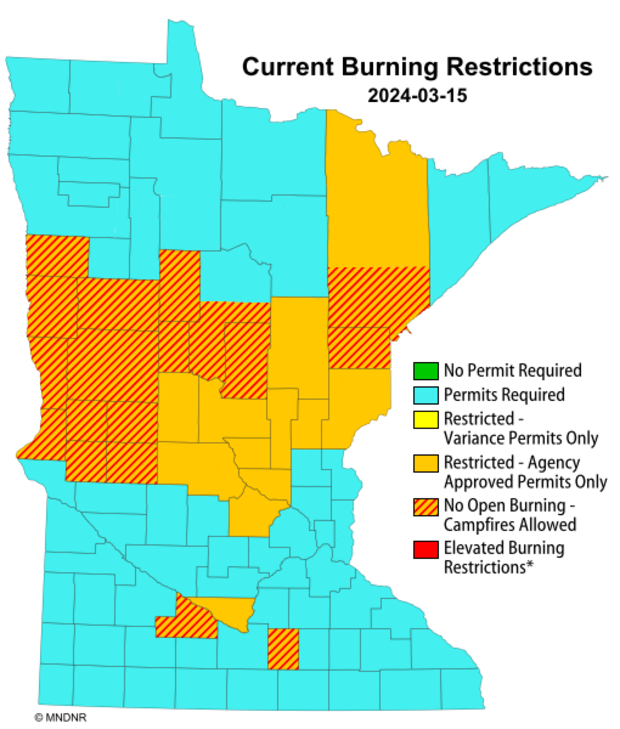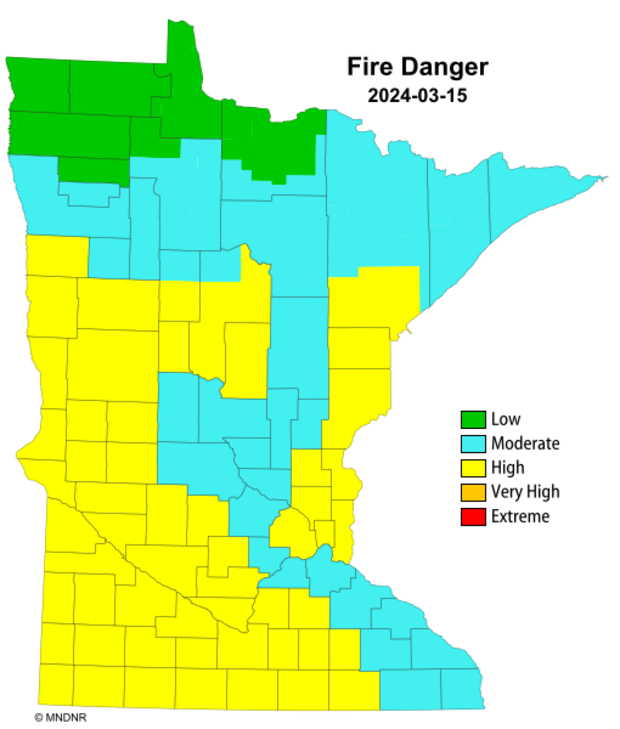Minnesota DNR sets burn restrictions in over 30 counties
MINNEAPOLIS — The Minnesota Department of Natural Resources announced on Friday that burn restrictions will go into place on Monday in over 30 counties due to unusually warm temperatures and dry conditions.
According to the DNR, the risk for wildfires increases when the snow melts before vegetations has a chance to green.
RELATED: Dry winter fueling early and active wildfire season across Minnesota
The DNR says that 90% of the time people are the cause for wildfires in Minnesota.
Burn restrictions will go in effect on the Mar. 18 for the following counties: Aitkin, Anoka, Becker, Beltrami, Benton, Carlton, Cass, Chisago, Clay, Clearwater, Crow Wing, Douglas, Grant, Hennepin, Hubbard, Isanti, Itasca, Kanabec, Mahnomen, Mille Lacs, Morrison, Norman, Otter Tail, Pine, Polk, Pope, Ramsey, Red Lake, Sherburne, the southern half of St. Louis County, Stearns, Stevens, Todd, Traverse, Wadena, Washington, Wilkins, and Wright.
At this time, the DNR will not be issuing permits for open burning of brush or yard waste to these counties until the restrictions are lifted.
WCCO's Ubah Ali discussed the underlying issues with DNR wildfire prevention specialist, Karen Harrison.
"This year, we've seen an early start to our wildfire season due to exceptionally warm winter temperatures and less than half the average snowfall across much of the state," said Harrison. "Spring burning restrictions help reduce the number of wildfires, especially those caused by debris burning."
Harrison thinks strong winds coupled with dry conditions from our warmest winter on record is a major concern.
"When we have these dry, windy conditions wildfires start really easy and spread really quickly," said Harrison.
It's only mid-March, but parts of the state are already under a fire weather watch. That's a step below a Red Flag Warning when a wildfire near Waseca sparked in early March.
Harrison said spring is when Minnesota sees the most wildfires occur. "In Minnesota, 90% of wildfires are caused by people, and the biggest cause of that is vegetated debris burning, so larger piles of brush."
Ubah Ali caught up with Gordy Leach picking up the pieces of trees infested with invasive emerald ash borers. Like many, Leach is unhappy with the dry conditions this season.
"It's nice to be able to use fire to get rid of some stuff you gotta get rid of at some point," said Leach.
Leach understands the importance of burning under the right conditions, so for now it's a waiting game.
"As time and weather allows," Leach explained. "I'll get them burned up eventually.
In place of burning, Harrison recommends alternative forms of yard waste disposal like composting, chipping, or taking brush to a collection site.
RELATED: How to protect your home from the threat of wildfires
If a Minnesota resident causes a fire that escapes and causes a wildfire, they are liable for any damage caused as well as wildfire suppression cost.
According to the National Interagency Fire Center, the cost for wildfire suppression in 2022 totaled a staggering $3,549,000,000. Over the last ten years, an average of $2,358,603,800 has been spent on wildfire suppression, per the NIFC.
An end date for the burn restrictions has not been set yet. The DNR says it's possible that restrictions will be adjusted as conditions change.
For more information, click here.





